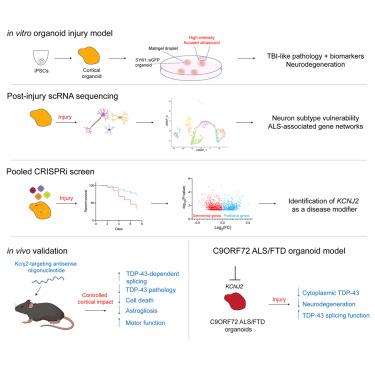Cell Stem Cell ( IF 23.9 ) Pub Date : 2024-04-04 , DOI: 10.1016/j.stem.2024.03.004 Jesse D. Lai , Joshua E. Berlind , Gabriella Fricklas , Cecilia Lie , Jean-Paul Urenda , Kelsey Lam , Naomi Sta Maria , Russell Jacobs , Violeta Yu , Zhen Zhao , Justin K. Ichida

|
Traumatic brain injury (TBI) strongly correlates with neurodegenerative disease. However, it remains unclear which neurodegenerative mechanisms are intrinsic to the brain and which strategies most potently mitigate these processes. We developed a high-intensity ultrasound platform to inflict mechanical injury to induced pluripotent stem cell (iPSC)-derived cortical organoids. Mechanically injured organoids elicit classic hallmarks of TBI, including neuronal death, tau phosphorylation, and TDP-43 nuclear egress. We found that deep-layer neurons were particularly vulnerable to injury and that TDP-43 proteinopathy promotes cell death. Injured organoids derived from C9ORF72 amyotrophic lateral sclerosis/frontotemporal dementia (ALS/FTD) patients displayed exacerbated TDP-43 dysfunction. Using genome-wide CRISPR interference screening, we identified a mechanosensory channel, KCNJ2, whose inhibition potently mitigated neurodegenerative processes in vitro and in vivo, including in C9ORF72 ALS/FTD organoids. Thus, targeting KCNJ2 may reduce acute neuronal death after brain injury, and we present a scalable, genetically flexible cerebral organoid model that may enable the identification of additional modifiers of mechanical stress.
中文翻译:

KCNJ2 抑制可减轻创伤性脑损伤的人脑类器官模型中的机械损伤
创伤性脑损伤(TBI)与神经退行性疾病密切相关。然而,目前尚不清楚哪些神经退行性机制是大脑固有的,以及哪些策略最有效地减轻这些过程。我们开发了一个高强度超声平台,可以对诱导多能干细胞(iPSC)衍生的皮质类器官造成机械损伤。机械损伤的类器官会引发 TBI 的典型特征,包括神经元死亡、tau 磷酸化和 TDP-43 核排出。我们发现深层神经元特别容易受到损伤,并且 TDP-43 蛋白病会促进细胞死亡。来自C9ORF72肌萎缩侧索硬化症/额颞叶痴呆 (ALS/FTD) 患者的损伤类器官表现出 TDP-43 功能障碍加剧。通过全基因组 CRISPR 干扰筛选,我们鉴定了一种机械感觉通道 KCNJ2,其抑制作用可有效减轻体外和体内的神经退行性过程,包括在C9ORF72 ALS/FTD 类器官中。因此,靶向 KCNJ2 可能会减少脑损伤后的急性神经元死亡,并且我们提出了一种可扩展的、遗传灵活的大脑类器官模型,该模型可能能够识别机械应力的其他调节剂。



























 京公网安备 11010802027423号
京公网安备 11010802027423号